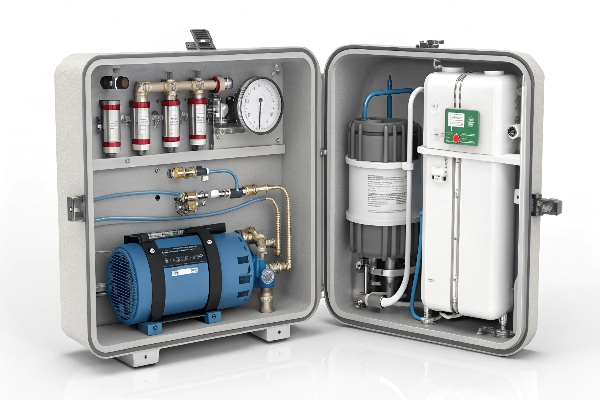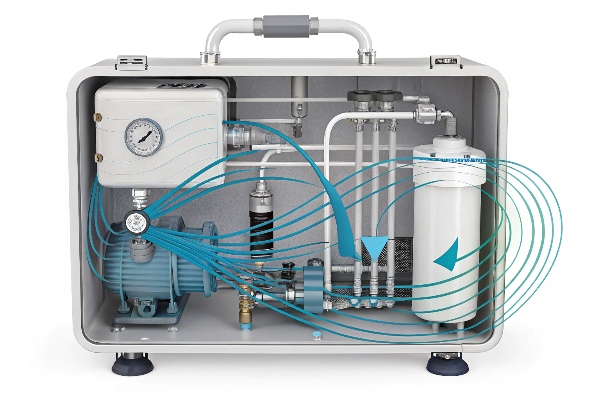Struggling to choose the right portable dental unit? Making the wrong choice can lead to unreliable performance and costly issues down the line. Focus on key features for success.
A high-quality portable dental unit must have a reliable oil-free air compressor, strong suction, a self-contained clean water system, standard handpiece connections, and durable, lightweight construction for true portability and ease of use.
Choosing the right portable dental unit is crucial, whether you’re designing one or sourcing it for a project. It’s not just about ticking boxes; it’s about ensuring reliable performance in potentially challenging environments. From my years working with manufacturers and designers like Jacky, I know that getting the details right saves a lot of headaches later. Let’s dive into what really makes a portable dental unit stand out in terms of quality and functionality. We need to look beyond the surface and understand the core elements that deliver value.
What are the features of a dental portable dental unit?
Confused about what defines a truly good portable dental unit? Overlooking essential features can mean poor performance when it matters most. Understanding these core capabilities helps you choose wisely.
Key features include an integrated oil-free compressor, an effective suction system, a self-contained water source, connections for standard air/water handpieces, compact design, and manageable weight for genuine portability.
!
When we talk about features, we’re really talking about the capabilities that make the unit effective and convenient. It’s more than just a box with tubes. Based on my experience helping clients specify these units, certain features are non-negotiable for quality.
Portability and Build
This seems obvious, but true portability is key. Look for:
- Weight: Ideally under 25kg (around 55 lbs), but lighter is better if durability isn’t compromised.
- Size: Compact dimensions for easy transport and storage.
- Handling: Sturdy handles, smooth-rolling casters (wheels), and perhaps a telescopic handle like luggage.
- Case Material: Durable materials like high-impact plastic or aluminum alloys that can withstand bumps during transport but aren’t excessively heavy.
Integrated Systems
A good unit needs to be self-sufficient.
- Air Compressor: An oil-free compressor is highly preferred. It means less maintenance, no risk of oil contaminating the air supply (crucial for patient safety and handpiece longevity), and often quieter operation. Check the airflow rate (L/min) and pressure (psi/bar) to ensure it can power the intended handpieces.
- Suction System: Must be powerful enough for effective aspiration. Look for specs on vacuum pressure (kPa or mmHg) and flow rate. Easy-to-clean collection canisters and filters are vital.
- Water System: A self-contained bottle system is standard. Ensure it’s easy to remove, refill, and disinfect. Some units might have options for connecting to an external water source, adding flexibility.
Handpiece Compatibility and Controls
The unit needs to work seamlessly with standard dental tools.
- Connections: Standard 4-hole (Midwest) or 2-hole (Borden) connectors for high-speed and low-speed handpieces.
- Air/Water Syringe: A 3-way syringe (air, water, spray) is essential.
-
Controls: Clear, accessible controls for power, water flow, air pressure, and suction. A foot pedal for handpiece activation is standard.
Here’s a quick comparison:Feature Basic Unit May Have High-Quality Unit Should Have Why it Matters Compressor Oil-lubricated, lower flow Oil-Free, sufficient flow/pressure Cleaner air, less maintenance Suction Basic aspiration Strong vacuum, easy-clean filter Effective waste removal Water Simple bottle Easy-refill/disinfect bottle Hygiene and convenience Portability Heavy, awkward Lighter weight, good handles/wheels Ease of transport Handpiece Output May struggle under load Consistent power delivery Reliable instrument performance Focusing on these core features ensures the unit you design or select is truly functional and reliable in the field.
What are the components of a portable dental unit?
Wondering what’s actually inside that compact case? Not knowing the internal parts makes it tough to judge the build quality and potential failure points. Let’s break down the essential components.
A typical portable dental unit contains an air compressor, vacuum pump (for suction), clean water bottle/system, air/water syringe, tubing for high/low-speed handpieces, control valves/switches, and a protective outer casing.

Understanding the main parts helps appreciate the engineering involved and assess quality. When I work with designers like Jacky, we often discuss how the choice and integration of these components impact overall performance and longevity.The Air System
This is the heart of the unit.
- Compressor: Usually a piston or diaphragm type. As mentioned, oil-free is the standard for quality units. Key specs are horsepower (HP), airflow (L/min or CFM), and maximum pressure (psi or bar). It needs to power handpieces without lagging.
- Air Tank (Optional but Recommended): Some units have a small accumulator tank to provide a smoother, more consistent air supply and reduce compressor cycling.
- Filters & Regulators: Essential for clean, dry air delivered at the correct pressure for handpieces.
The Suction System
Critical for removing fluids and debris.
- Vacuum Pump: Creates the negative pressure. Different technologies exist (e.g., diaphragm, rotary vane). Reliability and noise level are factors.
- Collection Canister: Where waste collects. Needs to be easily removable, cleanable, and often includes an overflow protection mechanism.
- Filters: Protect the pump from debris.
Water Delivery System
Provides water for cooling and irrigation.
- Water Bottle: Typically a standard size (e.g., 1 liter), made of durable plastic. Must seal well and be easy to handle.
- Tubing and Valves: Routes water to the syringe and handpiece connections. Needs to be resistant to biofilm buildup; periodic flushing is crucial.
Control and Interface
How the user operates the unit.
- Switches/Buttons: For main power, compressor, suction.
- Valves/Adjusters: To control water flow and air pressure to the handpieces.
- Foot Control (Rheostat): Standard for activating handpieces, often variable speed.
- Connectors: Standardized ports for attaching handpiece tubing and the air/water syringe.
The Housing
Protects the internal components.
- Material: High-impact polymers or metal alloys provide durability. Balance between protection and weight.
- Design: Should allow easy access for basic maintenance (e.g., changing filters, accessing water bottle). Good ventilation is needed for the compressor and pump.
Here’s a table linking components to their main function:
| Component | Primary Function | Key Quality Indicator |
|---|---|---|
| Air Compressor | Generates compressed air | Oil-free design, Flow rate |
| Vacuum Pump | Creates suction | Vacuum strength, Reliability |
| Water Bottle | Holds clean water supply | Ease of use, Seal quality |
| Handpiece Tubing | Delivers air/water to handpieces | Flexibility, Standard Connectors |
| Air/Water Syringe | Delivers air, water, or spray | Ergonomics, Leak-free seals |
| Control System | Manages unit functions (power, flow) | Reliability, Ease of use |
| Casing | Protects internal components | Durability, Portability |
Knowing these parts helps you ask the right questions when evaluating a unit’s design or specifications.
How does a portable dental unit work?
Curious about how these compact units manage to perform complex dental functions? Misunderstanding the internal workflow can lead to improper use. Knowing the basics makes operation much clearer.
Essentially, the unit’s compressor provides pressurized air to run handpieces and the syringe. Simultaneously, the vacuum pump creates suction to remove waste. The water system supplies clean water for cooling and cleaning, all managed via controls.

It’s quite clever how these units integrate multiple functions into one portable package. I’ve seen many designs over the years, and the core principle remains consistent: providing the essential utilities chairside, wherever that chair might be. Let’s follow the flow.
Generating Power (Air)
It starts with the electric motor driving the air compressor.
- Air Intake: The compressor draws in ambient air, often through a filter.
- Compression: Air is compressed to a required pressure (e.g., 80-100 psi). In oil-free models, Teflon-coated pistons or diaphragms are used, eliminating oil contamination.
- Storage/Regulation (if applicable): Air might go into a small receiver tank for consistency, then through a regulator to set the precise operating pressure for handpieces (typically around 30-40 psi for high-speeds).
- Delivery: Pressurized air is routed via tubing to the handpiece connectors and the air/water syringe. When the foot pedal is pressed or syringe button activated, valves open, allowing air to flow and drive the turbine (high-speed) or motor (low-speed), or exit the syringe nozzle.
Removing Waste (Suction)
Simultaneously, the suction system works:
- Vacuum Creation: The electric motor powers the vacuum pump, which creates negative pressure.
- Aspiration: This vacuum draws air, water, saliva, and debris from the patient’s mouth through the suction tip and tubing.
- Collection & Filtering: The aspirated material enters the collection canister. Solids/liquids are trapped, while air passes through filters (protecting the pump) and is expelled.
Providing Coolant/Rinse (Water)
The self-contained water system ensures cleanliness:
- Storage: Clean (often distilled) water is held in the pressurized bottle. Air pressure from the compressor might be used to push water out.
- Delivery: Water flows through tubing to the air/water syringe and the handpiece connectors.
- Application: When activated, water sprays from the syringe for rinsing or flows through the handpiece to cool the bur and treatment site during procedures. Flow rate can often be adjusted.
Control Interface
The user manages these systems via:
- Master Switches: Turn the main power, compressor, and suction on/off.
- Foot Pedal: Activates the selected handpiece, often controlling its speed.
- Handpiece Selection: Switches determine which handpiece receives air/water when the foot pedal is pressed.
- Flow Adjusters: Knobs or valves to fine-tune water and air spray for handpieces.
- Syringe Buttons: Separate buttons for air, water, or a combined spray.
This integrated system mimics the functionality of a fixed dental operatory but in a compact, movable form. Understanding this workflow helps users operate the unit effectively and troubleshoot basic issues.How do you maintain a portable dental unit?
Want your portable dental unit investment to last? Skipping regular maintenance inevitably leads to breakdowns, downtime, and costly repairs. Consistent, simple care keeps the unit running reliably.
Key maintenance includes daily wiping, flushing water lines, cleaning suction traps/filters weekly, draining any compressor moisture, and periodically checking tubing/connections. Always follow the manufacturer’s specific instructions.
From my experience in manufacturing and seeing equipment in use, maintenance is often overlooked, especially with portable gear that moves around. But it’s absolutely critical for performance and longevity. Think of it like maintaining a car; skipping oil changes leads to trouble. Here’s a breakdown of typical maintenance tasks:Daily Tasks (After Each Use Day)
- Exterior Wipe-Down: Clean the casing and controls with appropriate disinfectant wipes, following infection control protocols.
- Flush Water Lines: Run clean water through the handpiece tubing and air/water syringe for 20-30 seconds to remove residual water and minimize biofilm buildup. Empty the water bottle and let it air dry overnight.
- Run Suction Cleaner: Aspirate a recommended enzymatic cleaning solution through the suction tubing and HVE (High Volume Evacuator) / SE (Saliva Ejector) tips to dissolve debris.
- Empty Collection Canister: Dispose of waste according to local regulations and clean the canister.
Weekly Tasks
- Clean/Replace Suction Filter: Check the main suction filter(s). Clean or replace as per manufacturer guidelines to maintain strong suction. Traps near the suction tubing ends should also be checked and cleaned.
- Check Water Bottle Seal: Ensure the O-ring or seal is intact and clean to maintain pressure.
- Inspect Tubing: Look for kinks, cracks, or wear in all air, water, and suction tubing.
Periodic Maintenance (Monthly/Quarterly/Annually as per Manual)
- Drain Compressor Tank Moisture: If the unit has an air tank, drain any accumulated moisture (condensate) using the drain valve. This prevents internal rust and contamination (less common with small, oil-free units but check your manual).
- Check/Replace Air Filters: Inspect the compressor air intake filter and any other air filters; replace if dirty.
- Lubricate Handpieces: Follow handpiece manufacturer instructions (often done daily or between patients).
- Professional Servicing: Schedule check-ups as recommended by the manufacturer, which might include checking internal components, pressure calibration, and safety checks.
Importance of Manufacturer Manuals
Always, always refer to the specific manual for your unit model. It will provide detailed instructions, recommended cleaning agents, and schedules tailored to that design.
Here’s a simple maintenance schedule outline:
| Frequency | Task | Importance |
|---|---|---|
| Daily | Wipe exterior, Flush water lines | Infection Control, Biofilm |
| Daily | Run suction cleaner, Empty waste | Prevent clogs, Hygiene |
| Weekly | Clean/check suction filters | Maintain suction power |
| Weekly | Inspect tubing, water seal | Prevent leaks, ensure function |
| Monthly+ | Drain moisture (if applicable) | Prevent compressor damage |
| As Needed | Replace filters, Service | Long-term reliability |
Consistent maintenance takes only a few minutes each day but pays huge dividends in keeping the portable dental unit reliable and ready for use, protecting your investment and ensuring patient safety.
Conclusion
Choosing a high-quality portable dental unit means looking for reliable air/suction, clean water delivery, and true portability. Regular maintenance is key to ensuring it works well long-term.
